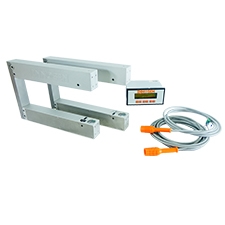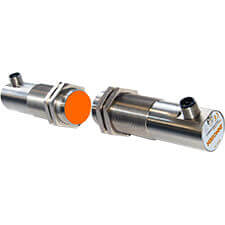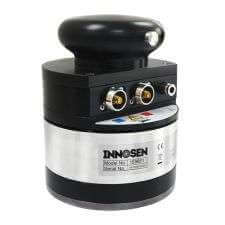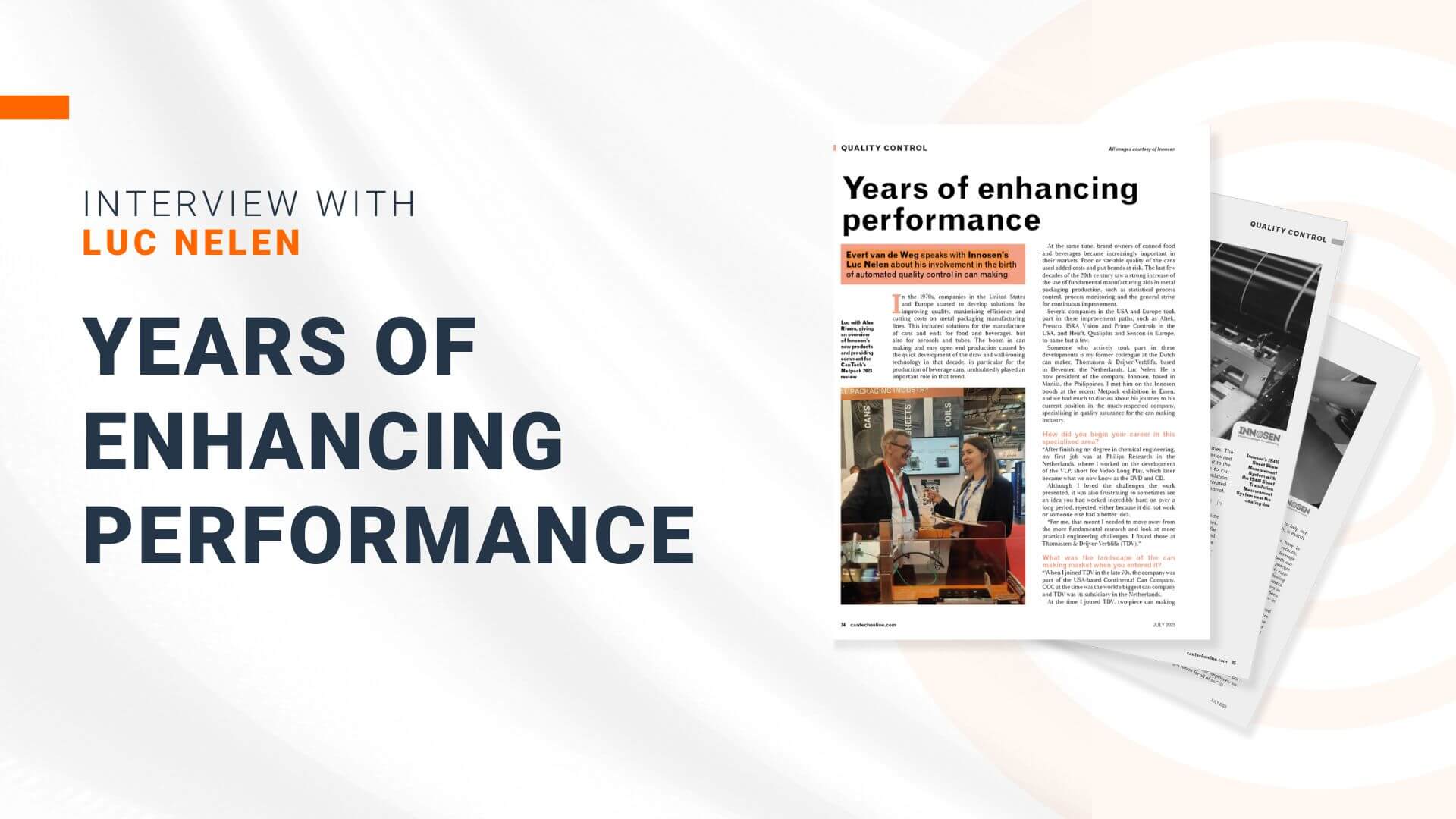
Years of enhancing performance
Written by: Evert van de Weg | cantechonline.com
Original Link: Cantech Online – Years of Enhancing Performance
Published: July 2023
Evert van de Weg speaks with Innosen’s Luc Nelen about his involvement in the birth of automated quality control in can making.
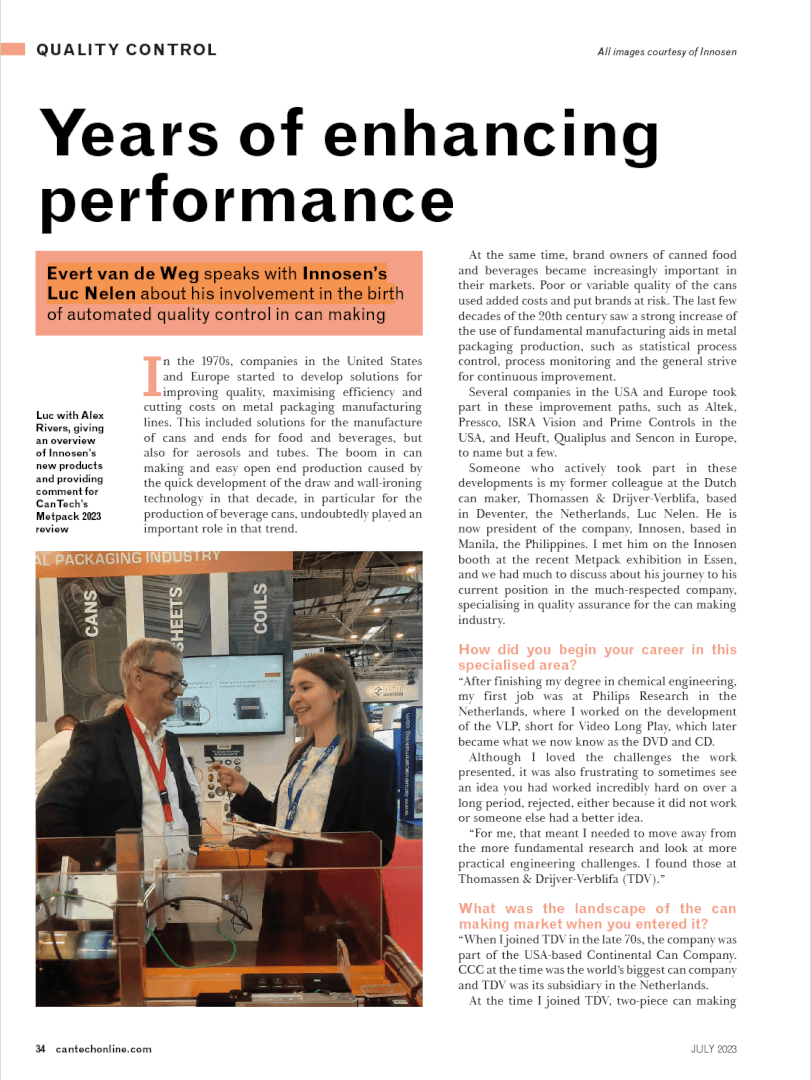
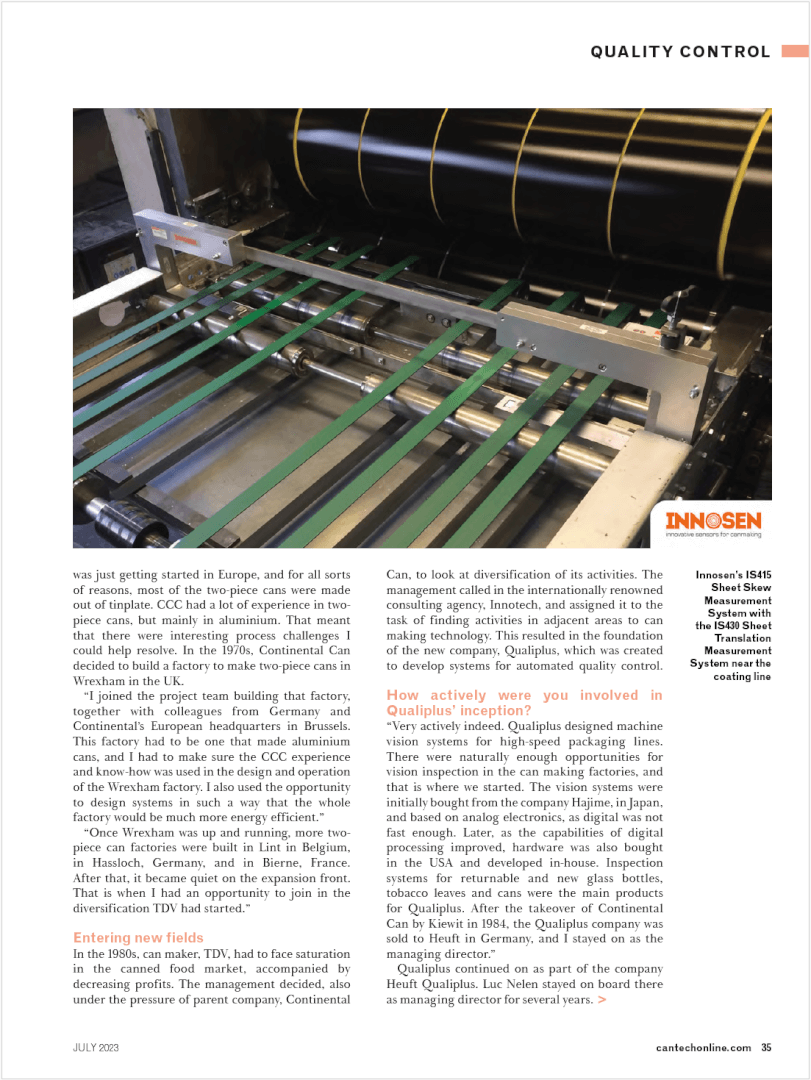
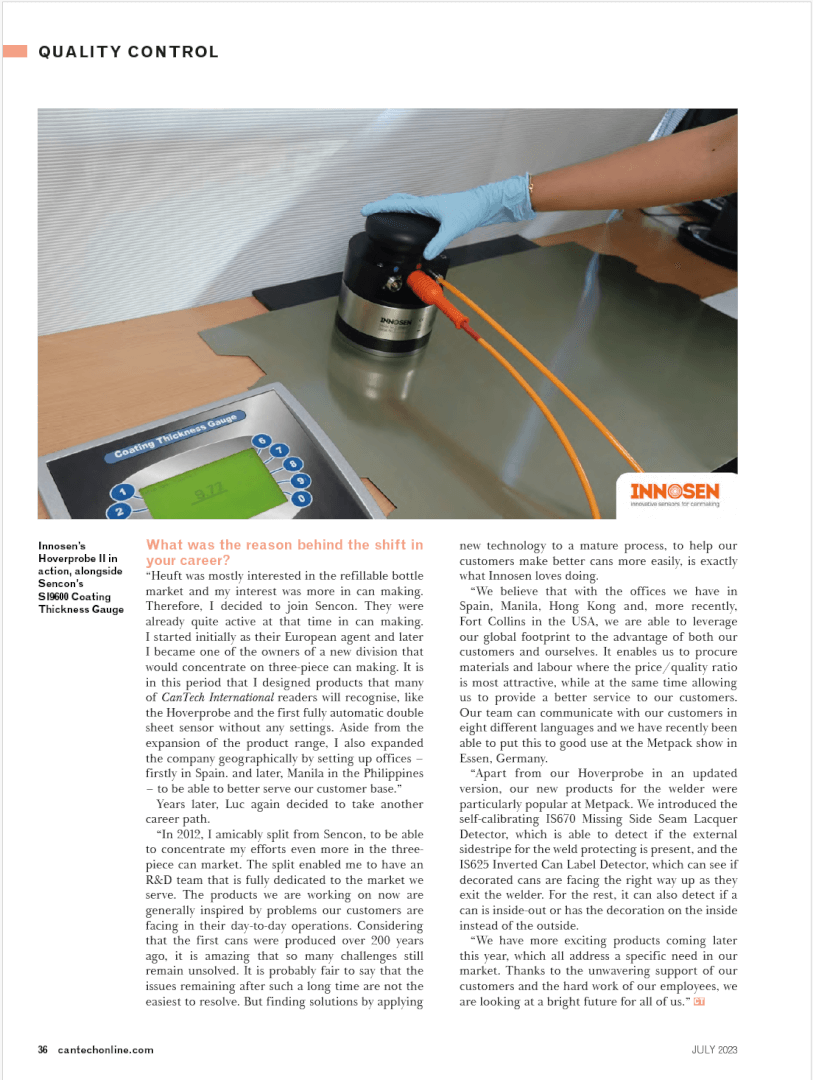
In the 1970s, companies in the United States and Europe started to develop solutions for improving quality, maximising efficiency, and cutting costs on metal packaging manufacturing lines. This included solutions for the manufacture of cans and ends for food and beverages, but also for aerosols and tubes. The boom in can making and easy open end production caused by the quick development of draw and wall-ironing technology in that decade, in particular for the production of beverage cans, undoubtedly played an important role in that trend.
At the same time, brand owners of canned food and beverages became increasingly important in their markets. Poor or variable quality of the cans used added costs and put brands at risk. The last few decades of the 20th century saw a strong increase of the use of fundamental manufacturing aids in metal packaging production, such as statistical process control, process monitoring and the general strive for continuous improvement. Several companies in the USA and Europe took part in these improvement paths, such as Altek, Pressco, ISRA Vision and Prime Controls in the USA, and Heuft, Qualiplus and Sencon in Europe, to name but a few. Someone who actively took part in these developments is my former colleague at the Dutch can maker, Thomassen & Drijver-Verblifa, based in Deventer, the Netherlands, Luc Nelen. He is now president of the company, Innosen, based in Manila, the Philippines. I met him on the Innosen booth at the recent Metpack exhibition in Essen, and we had much to discuss about his journey to his current position in the much-respected company, specialising in quality assurance for the can making industry.
How did you begin your career in this specialised area?
“After finishing my degree in chemical engineering, my first job was at Philips Research in the Netherlands, where I worked on the development of the VLP, short for Video Long Play, which later became what we now know as the DVD and CD. Although I loved the challenges the work
presented, it was also frustrating to sometimes see an idea you had worked incredibly hard on over a long period, rejected, either because it did not work or someone else had a better idea.
“For me, that meant I needed to move away from the more fundamental research and look at more practical engineering challenges. I found those at Thomassen & Drijver-Verblifa (TDV).”
What was the landscape of the can making market when you entered it?
“When I joined TDV in the late 70s, the company was part of the USA-based Continental Can Company. CCC at the time was the world’s biggest can company and TDV was its subsidiary in the Netherlands. At the time I joined TDV, two-piece can making was just getting started in Europe, and for all sorts of reasons, most of the two-piece cans were made out of tinplate. CCC had a lot of experience in two-piece cans, but mainly in aluminium. That meant that there were interesting process challenges I could help resolve. In the 1970s, Continental Can decided to build a factory to make two-piece cans in Wrexham in the UK.
“I joined the project team building that factory, together with colleagues from Germany and Continental’s European headquarters in Brussels. This factory had to be one that made aluminium cans, and I had to make sure the CCC experience and know-how was used in the design and operation of the Wrexham factory. I also used the opportunity to design systems in such a way that the whole factory would be much more energy efficient.
“Once Wrexham was up and running, more two-piece can factories were built in Lint in Belgium, in Hassloch, Germany, and in Bierne, France. After that, it became quiet on the expansion front. That is when I had an opportunity to join in the diversification TDV had started.”
Entering new fields
In the 1980s, can maker, TDV, had to face saturation in the canned food market, accompanied by decreasing profits. The management decided, also under the pressure of parent company, Continental Can, to look at diversification of its activities. The management called in the internationally renowned consulting agency, Innotech, and assigned it to the task of finding activities in adjacent areas to can making technology. This resulted in the foundation of the new company, Qualiplus, which was created to develop systems for automated quality control.
How actively were you involved in Qualiplus’ inception?
“Very actively indeed. Qualiplus designed machine vision systems for high-speed packaging lines. There were naturally enough opportunities for vision inspection in the can making factories, and that is where we started. The vision systems were initially bought from the company Hajime, in Japan, and based on analog electronics, as digital was not fast enough. Later, as the capabilities of digital processing improved, hardware was also bought in the USA and developed in-house. Inspection systems for returnable and new glass bottles, tobacco leaves and cans were the main products for Qualiplus. After the takeover of Continental Can by Kiewit in 1984, the Qualiplus company was sold to Heuft in Germany, and I stayed on as the managing director.”
Qualiplus continued on as part of the company Heuft Qualiplus. Luc Nelen stayed on board there as managing director for several years.
What was the reason behind the shift in your career?
“Heuft was mostly interested in the refillable bottle market and my interest was more in can making. Therefore, I decided to join Sencon. They were already quite active at that time in can making. I started initially as their European agent and later I became one of the owners of a new division that would concentrate on three-piece can making. It is in this period that I designed products that many of CanTech International readers will recognise, like the Hoverprobe and the first fully automatic double sheet sensor without any settings. Aside from the expansion of the product range, I also expanded the company geographically by setting up offices – firstly in Spain. and later, Manila in the Philippines – to be able to better serve our customer base.” Years later, Luc again decided to take another career path.
“In 2012, I amicably split from Sencon, to be able to concentrate my efforts even more in the three-piece /can market. The split enabled me to have an R&D team that is fully dedicated to the market we serve.
“The products we are working on now are generally inspired by problems our customers are facing in their day-to-day operations. Considering that the first cans were produced over 200 years ago, it is amazing that so many challenges still remain unsolved.It is probably fair to say that the issues remaining after such a long time are not the easiest to resolve. But finding solutions by applying new technology to a mature process, to help our customers make better cans more easily, is exactly what Innosen loves doing.
“We believe that with the offices we have in Spain, Manila, Hong Kong and, more recently, Fort Collins in the USA, we are able to leverage our global footprint to the advantage of both our customers and ourselves. It enables us to procure materials and labour where the price/quality ratio
is most attractive, while at the same time allowing us to provide a better service to our customers. Our team can communicate with our customers in eight different languages and we have recently been able to put this to good use at the Metpack show in Essen, Germany.
“Apart from our Hoverprobe in an updated version, our new products for the welder were particularly popular at Metpack. We introduced the self-calibrating IS670 Missing Side Seam Lacquer Detector, which is able to detect if the external sidestripe for the weld protecting is present, and the
IS625 Inverted Can Label Detector, which can see if decorated cans are facing the right way up as they exit the welder. For the rest, it can also detect if a can is inside-out or has the decoration on the inside instead of the outside.
“We have more exciting products coming later this year, which all address a specific need in our market. Thanks to the unwavering support of our customers and the hard work of our employees, we are looking at a bright future for all of us.”
Bestselling Sensors:
Sheet Skew Measurement System IS416
Protects against poorly placed coating by detecting skewed (rotated) sheets at the coater.
Double Sheet Detector IS231
Protects production against double sheets without requiring any operator adjustments.
Hoverprobe II IS9651
The newest version of the Hoverprobe. Tests coating thickness on flat sheets with world-class R&R.
OFFICES
Spain
Romà Piera i Arcal, 8
08330 Premià de Mar (Barcelona)
Spain
Main Multilanguage Tel:
+34 937 549 526
Email: [email protected]
Hong Kong
11th Floor Dah Sing Life Building
99 Des Voeux Road Central
Hong Kong
Tel: +852 2127 0699
Philippines
808 Citystate Centre Building
709 Shaw Boulevard
1600 Pasig City
Philippines
Tel: +63 2 8696 6965 /
+63 2 8696 6978
USA
7691 N.Overland Trail
80524 Fort Collins
Colorado
USA
Tel: +1 970 305 8721

